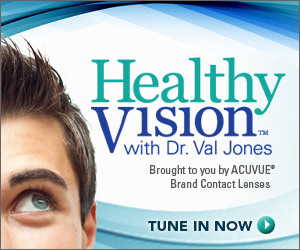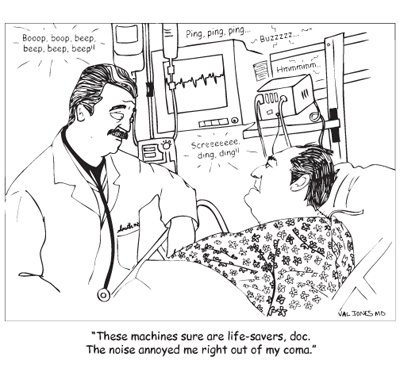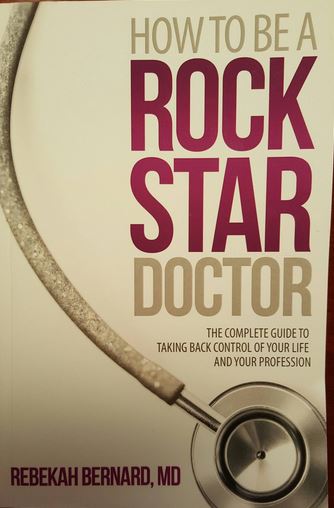December 24th, 2012 by Dr. Val Jones in Book Reviews, Quackery Exposed
No Comments »
 I am hesitant to review diet books because they are so often a tangled mess of fact and fiction. Teasing out their truth from falsehood is about as exhausting as delousing a long-haired elementary school student. However, after being approached by the authors’ PR agency with the promise of a book that contains science-based nutrition information I decided to agree to the review. This is how the book was described to me in an email:
I am hesitant to review diet books because they are so often a tangled mess of fact and fiction. Teasing out their truth from falsehood is about as exhausting as delousing a long-haired elementary school student. However, after being approached by the authors’ PR agency with the promise of a book that contains science-based nutrition information I decided to agree to the review. This is how the book was described to me in an email:
In their provocative new book, Eat to Save Your Life, best-selling authors Dr. Jerre Paquette and Gloria Askew, RRN, sort through the piles of information and misinformation about nutrition to reveal the true connection between food and health. Fed up with the advertising hype and conflicting nutritional advice, the duo provides common sense explanations for consumers everywhere who are looking to make smart nutritional choices.
Unfortunately, I was sold (quite predictably) a bill of goods. And rather than ignore the book and simply not do a review, I figured that maybe a negative review would reduce the number of incoming PR requests for future tomes of pseudoscience. In the end, I’ll probably just become the focus of personal attacks by dedicated proponents of various snake oils.
That being said, I thought it might be somewhat instructive to remind Better Health readers of certain basic “warning signs of pseudoscience” that I accidentally overlooked in agreeing to review the book. For a more complete review of similar “signs” I highly recommend Dr. David Gorski’s 2007 classic, humorous take on predictable arguments and behaviors of alternative medicine proponents (written in the style of comedian Jeff Foxworthy). As for me, I tend to think of much of the world of integrative medicine as a militant group of bakers eager to add odd, inert and occasionally toxic substances to cake recipes.
And so, without further ado, here is a small sample of what authors Askew and Paquette have added to their half-true diet book recipe:
- The “one true cause” fallacy: The book opens with an interesting review of vitamin C deficiency, noting that it (apparently) took the British Royal Navy 40 years before they accepted that the treatment for scurvy was citrus extract (rather than flogging). Citing this incident as an example of nutritional deficiency leading to life-threatening illness, it’s a short ride to the “one true cause” fallacy whereby the authors postulate that there are untold numbers of modern diseases caused by unrecognized nutritional deficiency syndromes. Nutritional deficiency may be the one true cause of most diseases, you see.
- The appeal to research without references. Countless appeals are made to “mounting evidence” of this and that (arthritis being caused primarily by food-related inflammation for example), either without reference footnotes, or with mentions of sources of dubious credibility (such as the Canadian Association of Naturopathic Doctors).
- The appeal to supplements in lieu of vaccines. No diet advice would be complete without a gratuitous attack on vaccines, right? The authors suggest that flu vaccines (for example) only provide immunity for 2 months “and only for certain individuals.” Meanwhile, they assert that a combination of Echinacea, garlic, and vitamin C support the immune system to successfully fight of viruses. These claims are simply unproven and multiple studies have already found no benefit (over placebo) of these supplements at preventing and treating the common cold.
- Over-diagnosis. If you think that the world of medicine is predisposed to seeing disease where there is none, try the alternative medicine world. The authors assert that everything from zits, to rashes, to “brain fog” are potential signs of grave underlying immune compromise – caused by, you guessed it, dietary deficiencies.
- Over-supplementation. The authors argue that “supplementation is a necessity in our nutrient-robbed world.” However, new evidence doesn’t support supplementation for the general population, though it had beentraditionally felt that multi-vitamins might be valuable. In addition, new studies are finding that food sources are preferable to supplements for daily nutritional requirements (such as calcium) and that anti-oxidants such as vitamin E may do more harm than good.
- The “organic is more nutritious” argument. Although a recent systematic review of the scientific literature found no support for the notion that organic foods contain more nutrients than those grown with traditional methods, the authors attribute Americans’ supposed vitamin deficiencies to poor soil quality caused by non-organic farming methods.
- Nutrigenomics and DNA hype. The authors do not take a sufficiently skeptical view of the emerging field of nutrigenomics (whereby certain foods and supplements are recommended to individuals based on their genetic profiles). They even suggest that nutrigenomic testing is so much fun, it’s “almost like being part of a CSI television show.” Who cares if it’s no more accurate than fortune telling?
So what’s the half true part? Well, obesity is certainly a driver of many modern illnesses, and obesity is caused by (in no small part) nutritional choices. The authors cite statistics on the ravages of heart disease, high blood pressure, and diabetes on the U.S. population which are all quite true. (How this supports the “deficiency” argument is somewhat lost on me – because it would seem more logical that a possible excess of nutrients could be the “one true cause” of a lot of these diseases, but I digress).
There are real nutritional deficiencies that cause medical problems, such as iron-deficiency anemia, neural tube defects related to folic acid deficiency, vitamin D deficiency and rickets, and osteoporosis contributed to by low calcium levels. These conditions underscore the importance of healthy eating habits, but do not support the idea that the entire population is deficient in these nutrients. In fact, a large population study analyzed by the CDC, suggests that most Americans are not deficient in any major nutrient even with their current sub-optimal and obesogenic eating habits.
In general, fair-minded individuals will find Eat To Save Your Life to be yet another example of a half-true, hysteria-peddling, micro-nutrient-obsessed diet advice book. Ironically, the book’s title itself states the opposite of what we really need to be doing to reduce obesity-related diseases: stop eating (so much) to save our lives.
This book may be purchased (against my medical advice) at Amazon.com.
***
This post originally appeared at the Science Based Medicine blog.
December 19th, 2012 by Dr. Val Jones in Health Tips
No Comments »
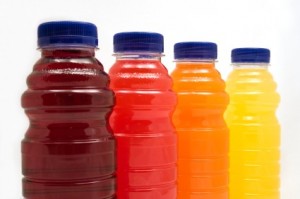 This year’s finalists for the Boys & Girls Clubs’ Fit Family Challenge are about to be announced. I’ve had the privilege of acting as nutrition coach for the semi-finalist families, and have had fantastic interactions with them about common nutrition questions. In my continuing Q&A series, I thought I’d share some of our email conversations:
This year’s finalists for the Boys & Girls Clubs’ Fit Family Challenge are about to be announced. I’ve had the privilege of acting as nutrition coach for the semi-finalist families, and have had fantastic interactions with them about common nutrition questions. In my continuing Q&A series, I thought I’d share some of our email conversations:
Q: How many calories do I need per day, and how many should I eat to lose weight?
I like to use this Mayo Clinic calculator to get a rough estimate of daily caloric needs. If you enter your height, weight, age, and activity level it will tell you approximately how many calories/day you need to maintain your weight. To lose one pound a week, you need to subtract 500 calories/day from that number. So, for example if the calculator suggests that you need 2000 calories/day – you should follow a 1500 calorie/day diet to lose 1 pound a week. Studies have shown that people who drop more than 500 calories below their daily maintenance needs have a hard time sticking to their diet. You may feel weak, trembly, and irritable if you cut down too low too fast. You will have to play with the amount a little bit since the calculator is not exact – if you don’t see the scale moving when you cut out 500/day, then you have to wonder if you’re counting calories correctly or perhaps if you have to go a little bit lower still. Unfortunately, the “reward” for losing weight is that you have to permanently eat less when you are at your desired goal because there is less of you to feed!
Q: What do you think about sports drinks? Do my kids need them when running races?
As far as sports drinks are concerned, their benefits are often over-hyped and exaggerated. That being said, I believe they do have a role in hydration during endurance sports like long distance running. When you do strenuous exercise for long periods of time (over 1 hour of effort) you lose a lot of body salt and minerals (electrolytes) in your sweat. It’s important to replace certain key electrolytes so your body doesn’t become depleted and begin to cramp. This is more likely to happen to folks running very long distances, such as marathons and triathlons. However, if it’s hot during your race, you could be at risk for dehydration and electrolyte loss as well.
Regular Gatorade (made by Pepsi Co.) has water, sugar, sodium, and potassium in it. Powerade (made by Coca Cola) has water, sugar, sodium, potassium and B vitamins. Powerade has a little bit higher sugar concentration, which could be an advantage on a long run. Both are reasonable choices for hydration during a race.
The rough rule of thumb is to take in 6-12 oz of fluid for every 20 minutes of running. Water is sufficient for runs that last less than an hour. Sports drinks (or adding electrolyte gels/chomps to water) are helpful if your run will last longer than an hour. It’s better to sip the water slowly at regular intervals than to dry to gulp it all down at one time. You may feel nauseated or have a “sloshy stomach” feeling if you don’t spread out your hydration.
Sports drinks can be quite expensive – and you can easily create your own at home. The World Health Organization has a simple recipe for rehydration fluids, and I found this (probably slightly tastier) version on a blog site.
Outside of endurance sports, I don’t see a physiologic need for sports drinks (with the exception of extreme sweating in hot weather or during illness with vomiting and diarrhea) – they can add unnecessary calories to your diet.
Q: Should I cut down the amount of salt in my diet?
Not necessarily. Too little salt, as well as too much salt, have both been shown to be unhealthy. If you’re eating a lot of fast food, you’re probably getting too much salt. If you cook for yourself and focus on fruits and veggies, whole grains, and lean protein you may not need to cut back. Unless you have a kidney problem or very high blood pressure, salt is generally not dangerous for you. About 2.5g of salt/day (roughly a teaspoon full) is optimal, but for most people up to 4g/day probably won’t hurt (and at least one study suggests that heart disease risk doesn’t increase until the daily intake of salt exceeds 7g/day).
December 11th, 2012 by Dr. Val Jones in Health Tips
No Comments »
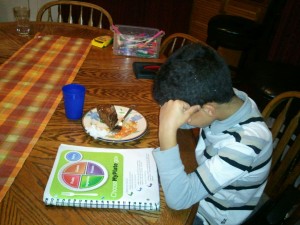 I’ve continued to have terrific email questions and answers with the Boys & Girls Clubs’ Fit Family Challenge participants. I thought I’d publish some of our conversations so that you can participate as well. The Lang family shared this image of their son eating dinner next to the latest USDA dietary recommendations “MyPlate” materials. A picture’s worth 1000 words, isn’t it?
I’ve continued to have terrific email questions and answers with the Boys & Girls Clubs’ Fit Family Challenge participants. I thought I’d publish some of our conversations so that you can participate as well. The Lang family shared this image of their son eating dinner next to the latest USDA dietary recommendations “MyPlate” materials. A picture’s worth 1000 words, isn’t it?
This cute fella is a healthy weight, he is very athletic, and he’s also wondering where chicken nuggets, french fries, and pizza fit in to the MyPlate dinner plans… His mom asked me how to make more “kid friendly” healthy meals. Perhaps some folks reading this have some success stories that they’d like to share? Here’s what I had to say to the Langs and others…
1. My son doesn’t think the MyPlate suggested meals are kid friendly. What can we do?
I wonder if your son would be open to trying healthier variations of the foods he likes? You could make a pretty tasty pizza with whole wheat crust, grilled veggies, a little pesto or tomato sauce and some ham cubes (ham is much lower in fat than sausage or pepperoni) and low fat shredded mozzarella. You can get a pizza stone to help crisp the crust in a regular oven. The pizza would probably reheat well so you could make it in advance too.You can bread chicken strips and bake them (instead of frying them) to simulate healthy chicken “nuggets.” Same for fish sticks. You can try sweet potato fries for a healthier fry option – bake them in the oven with a little olive oil, salt and pepper. More nutritious, kid-friendly recipes may be found at KidsHealth.org
2. Do my kids need 8 cups of water a day?
As far as water is concerned, the amount you need really depends on how much liquid you’re getting from other sources (food, beverages) as well as how much you’re sweating (exercise), how hot/dry the environment is and how much you weigh. Eight cups/day is a very rough rule of thumb. Some people need more or less depending on the day. Unless you are doing extreme exercise (in the heat) that requires fluid replacement before you notice that you’re thirsty, thirst is a good indicator of whether or not you need to drink. Also, I’ll tell you a doctor secret – all you need to know about hydration is in your urine color. Urine becomes very concentrated (dark yellow) when you are dehydrated. If you drink enough water to keep your urine a nice light yellow, then that’s all you need.
3. What are the best vegan protein substitutes for meat?
Concentrated vegetable protein is primarily derived from soy (tofu and tempeh) and wheat (seitan). Nuts and seeds also contain some degree of protein, as well as beans, lentils, and rice. Tofu, tempeh, and seitan can be molded into burger and hotdog shapes and may be prepared to mimic meat flavors. Keep in mind that concentrated soy or wheat proteins may not agree with your intestinal tract (some complain of excessive gas and bloating). So if you have those reactions, at least you’ll know that it’s quite common.
4. Is it healthy to be a vegetarian? Is there such a thing as too much fruit and veggies?
Vegetarianism can be healthy, though it takes some effort to ensure that adequate amounts of nutrients are received – especially if you’re vegan (no dairy, no eggs). The most common deficiencies for vegans are iron, B12, calcium, Omega-3 fatty acids, protein, and Vitamin D. (You can read more about how vegetarians can overcome these deficiencies here.) I guess my main concern with veganism is the low omega-3s. It is basically impossible to get enough omega-3 fatty acids from plant sources (certain seeds, you may have heard, have a good amount of omega-3 fatty acids but what they won’t tell you is that plant omega-3’s aren’t processed by the body so they remain inactive and don’t provide much benefit.) Omega 3 fatty acids form a protective layer on the outside of cell membranes by reducing inflammation. This is particularly helpful in the reduction of plaque build up in heart arteries, and reducing the risk of various dementias (such as Alzheimer’s) that have an inflammatory cause.
Excellent sources of omega 3 fatty acids are oily fish (sardines, salmon, mackerel, sea bass). This is why the American Heart Association (and MyPlate.gov) recommend 2 servings of oily fish/week for optimal health. Vegetarians are missing out on this important benefit.
As far as eating too many fruits/veggies is concerned – I can’t think of too many potential harms from eating large amounts of fruits/veggies (other than weight gain if you really eat a lot of fruit – they have quite a bit of natural sugar). The real harm comes from excluding vital nutrients by eating plants exclusively (without a careful strategy to get the right plant sources of vitamins and minerals, along with omega-3 supplements).
December 7th, 2012 by Dr. Val Jones in Health Tips
No Comments »
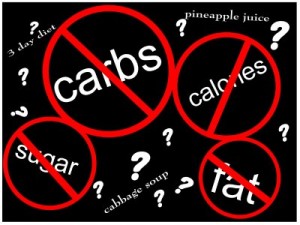 This year’s Fit Family Challenge competitors are smart, savvy, and full of great nutrition-related questions! I just finished a one hour conference call with 10 family finalists from across the U.S. and Hawaii. As part of their challenge to adopt healthy diet and exercise practices, they were asked to send me their most burning nutrition questions. One mom told me that her goal was “to teach her girls how to think critically” about health information. I was so pleased to see those values being promoted that I thought I’d share some of our mythbusting FAQs here on the blog:
This year’s Fit Family Challenge competitors are smart, savvy, and full of great nutrition-related questions! I just finished a one hour conference call with 10 family finalists from across the U.S. and Hawaii. As part of their challenge to adopt healthy diet and exercise practices, they were asked to send me their most burning nutrition questions. One mom told me that her goal was “to teach her girls how to think critically” about health information. I was so pleased to see those values being promoted that I thought I’d share some of our mythbusting FAQs here on the blog:
1. I live in a community that doesn’t add fluoride to the public water supply. Do my kids need to take fluoride supplements?
Fluoridation of our water supply is considered to be one of the top 10 most effective public health initiatives of the 20th century. Enhancing the natural fluoride content of water results in up to a 60% reduction in tooth decay for kids! The cost to a community of adding fluoride to the water supply is about 50 cents per person per year, so it’s really quite affordable. I’m not sure why your community water hasn’t been fluoridated, but it’s estimated that about 1/3 of Americans still live in communities that haven’t supplemented their water with fluoride (so you’re not alone).
Our teeth use fluoride to strengthen our enamel – and we can get fluoride to our teeth in two ways: 1) from our blood stream (e.g from the water we drink, digest, and absorb) and 2) topically (e.g. from toothpaste). Studies have shown that it’s best to get fluoride via both routes for optimal enamel strength. For children living in areas where the water is not fluoridated, the American Dental Association (ADA) recommends fluoride vitamins until at least age 16. There are two strengths of fluoride vitamins, and the dosage required depends on the fluoride levels in the local water supply (you can ask your local Water Department for that information if you haven’t already). Keep in mind that most children’s permanent teeth (with the exception of “wisdom teeth”) erupt by age 13 – and before that age there is no way to get fluoride to them except via the blood stream. So digesting fluoride (via water or vitamins) is critical to strengthen those teeth that haven’t broken through the gums yet.
For more information about fluoride, see this helpful ADA guide.
2. Should parents be concerned about hormone levels in milk? Is there an advantage to buying organic milk?
All mammals release trace amounts of hormones into their milk. Cow’s milk naturally contains a small amount of bovine somatotropin (bST) which is a protein that is quickly broken down by our stomachs when we drink milk. Some farmers give their cows additional amounts of the hormone to stimulate milk production. This rbST (or BGH) is virtually identical to naturally occurring cow hormones and the decades of research we’ve collected has been reviewed by the FDA (Food and Drug Association), WHO (World Health Organization), NIH (National Institutes of Health), AMA (American Medical Association), and ADA (American Dietetic Organization) – and all agree that rbST is safe for human consumption in the levels it occurs in cow’s milk. Interestingly, studies have shown that milk hormone levels in organic milk is essentially identical to levels in regular milk. There is therefore no advantage in buying organic milk insofar as hormones are concerned.
I believe that cow’s milk is safe and nutritious for kids (so long as they have no milk allergies or lactose intolerances). The milk/hormone scare is kind of an urban legend, so I wouldn’t be too worried about it. Your girls haven’t suffered any harm from drinking regular milk – and it’s great that you all enjoy the skim variety, by the way. Lower calorie options can help you maintain your weight over your lifetime.
For more information about milk and hormones please check out this helpful link full of research resources.
3. Are there lifestyle choices that I can make to reduce my risk of getting cancer? Can vitamins help?
You are right that there are lifestyle choices that can substantially reduce your risk (and your childrens’ risk) of getting cancer. However, there is no way to guarantee that you’ll never get cancer, no matter how carefully you control your diet and lifestyle. Nevertheless it’s an excellent idea to do what we can to reduce our risks. Cancer is actually a complicated collection of different diseases, and so specific behavior changes may reduce the risk of certain cancers but not others. For example, a high fiber diet may reduce the risk of colon cancer, but not skin cancer.
Also note that it’s very hard to prove that any one dietary change (such as consuming a larger amount of one particular vitamin or herb) has a direct impact on cancer risk. What works is sometimes more general (such as avoiding becoming obese). Here are some behavior changes that have been scientifically proven to reduce cancer risks or prevent certain cancers:
1. Smoking cessation
2. Regular use of sunscreen
3. A diet rich in fiber (i.e.lots of fruits and veggies and whole grains)
4. Maintaining a healthy weight
5. Regular exercise
6. HPV vaccines (especially for young girls – can prevent cervical cancer) and hepatitis vaccines (can prevent liver cancer)
7. Drinking very little alcohol (no more than 1 drink/day)
Screening for cancer is also important – because catching a cancer early is often the best way to cure it. The most effective screening tests are:
1. Colonoscopies (for adults over age 50)
2. PAP smears (for sexually active women and women who haven’t had hysterectomies)
3. Physical exams to check for skin cancer, oral cancer, and testicular cancers
Mammograms and prostate blood tests are less effective at catching cancers early, but they are recommended by most medical professional associations.
I recommend reading this page at the National Cancer Institute for more information about avoiding cancer risk factors:
Multivitamins are not recommended for cancer prevention. Although it would seem that vitamins could help reduce the risk of cancer, large studies have shown that they do not reduce the risk of cancer, and may even increase one’s risk (especially vitamin E.) The best source of vitamins is healthy food – and their fiber benefits are excellent as well. For a nice summary of the unhelpfulness of vitamin supplements, please see this ABC News summary of recent research.
November 30th, 2012 by Dr. Val Jones in Book Reviews
No Comments »
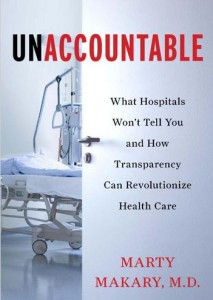 I met Dr. Marty Makary over lunch at Founding Farmers restaurant in DC about three years ago. We had an animated conversation about hospital safety, the potential contribution of checklists to reducing medical errors, and his upcoming book about the need for more transparency in the healthcare system. Marty was well dressed and soft spoken – sincere, and human. We exchanged business cards and wished each other luck in changing the healthcare system for the better. We were two doctors tilting at windmills.
I met Dr. Marty Makary over lunch at Founding Farmers restaurant in DC about three years ago. We had an animated conversation about hospital safety, the potential contribution of checklists to reducing medical errors, and his upcoming book about the need for more transparency in the healthcare system. Marty was well dressed and soft spoken – sincere, and human. We exchanged business cards and wished each other luck in changing the healthcare system for the better. We were two doctors tilting at windmills.
Just two months ago my fiancé sent me a “must read” article from the Wall Street Journal. It was Marty’s provocative piece, “How To Stop Hospitals From Killing Us.” The article was an excellent primer for his book, “Unaccountable: What Hospitals Won’t Tell You And How Transparency Can Revolutionize Health Care” which I highly recommend (holiday gifts, anyone?)
Unaccountable is both horrifying and oddly optimistic. Marty describes case after case of medical errors, lapses in judgment, and near misses in the surgical suite. He exposes the cultural foibles of the medical and hospital hierarchy, leaving no dirty stone unturned. Surgical delinquents such as Dr. Hodad (“hands-of-death-and-destruction”) are presented with detached accuracy, along with a clear list of reasons why the system fails to prevent the Hodads of the world from operating.
From the micro (individual physician mistakes) to the macro (trends in hospital safety breakdowns), Marty turns to survey data to make sense of the shortcomings. Interestingly, hospital “culture” (rated by its own employees) is the most predictive of overall hospital safety performance. Detailed record keeping of surgical complication rates correlates strongly with how employees rate their hospital on three simple questions:
1. Would you have your operation at the hospital in which you work?
2. Do you feel comfortable speaking up when you have a safety concern?
3. Does the teamwork here promote doing what’s right for the patient?
Marty’s conclusion that culture is the defining factor in patient safety and satisfaction ratings is both accurate and squishy. It’s difficult to create a reproducible template for a healthy work culture, and yet good culture is the basis for the success of hospitals such as the Mayo Clinic. Individual hospitals, like individual surgeons, have different personalities and temperaments. Raising them to be upstanding citizens involves a combination of good parenting and good luck.
Because I think Marty is absolutely right about culture as the foundation for safe and effective care, I think he’s also overly optimistic about the potential success of strategies to reproduce caring hospital cultures. By his own admission, not even the Mayo Clinic “mother ship” in Rochester, MN, has been able to create the exact level of quality care in its sister hospitals in Scottsdale, AZ, and Jacksonville, FL. So how can we dramatically improve patient care on a national level? Marty suggests that we need to find ways to force hospitals to become more transparent in order to revolutionize healthcare. His ideas include:
1. Mandatory hospital public reporting of patient re-admissions, complication rates, and never events.
2. Adoption of check lists by surgical teams to reduce errors.
3. Installation of video cameras throughout hospital floors and surgical suites so that staff behaviors can be monitored more effectively (e.g. to enforce hand washing or identify surgeons who have high error rates).
4. Accessible and transferable medical records that put patients at the center of their documentation.
While these ideas have merit, I believe they will fall short of achieving our ultimate goals. In my view, a culture of accountability is not the same as a culture of caring. Adopting certain “Big Brother” (cf. #3 above) strategies to pressure staff to behave/perform appropriately is only going to force the Hodads underground. We need staff to genuinely care enough about their patients to gang up on the Hodads and kick them out of the hospital for good. Caring doesn’t happen at a national level, it is personal and local. That’s why individual hospitals must develop their unique cultures for themselves, with progress measured by responses to those staff questions about whether or not they’d want to be cared for at their own institution.
I agree with Marty that hospital data transparency might be the best antiseptic we have to scrub the underbelly of medicine, though the ultimate success of our procedures will always be culture and surgeon-dependent. And that’s something you can’t regulate from Washington.
***
Marty’s book is available for purchase at Amazon.com.
Check out your local hospital safety scores from LeapFrogGroup.
 I am hesitant to review diet books because they are so often a tangled mess of fact and fiction. Teasing out their truth from falsehood is about as exhausting as delousing a long-haired elementary school student. However, after being approached by the authors’ PR agency with the promise of a book that contains science-based nutrition information I decided to agree to the review. This is how the book was described to me in an email:
I am hesitant to review diet books because they are so often a tangled mess of fact and fiction. Teasing out their truth from falsehood is about as exhausting as delousing a long-haired elementary school student. However, after being approached by the authors’ PR agency with the promise of a book that contains science-based nutrition information I decided to agree to the review. This is how the book was described to me in an email:

 This year’s finalists for the Boys & Girls Clubs’
This year’s finalists for the Boys & Girls Clubs’  I’ve continued to have
I’ve continued to have This year’s
This year’s I met Dr. Marty Makary over lunch at
I met Dr. Marty Makary over lunch at 